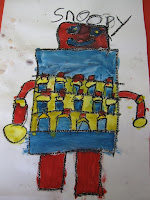
Wednesday, January 20, 2016
1st Grade Robots
As part of a new art assessment through MAEIA, 1st graders created these robots to show their knowledge of geometric shapes and primary colors. Each robot also has a job. Be sure to ask your first grader what their robot does!


Monday, January 18, 2016
O'Keefe Inspired Butterflies
Third Grade students looked at artwork by Georgia O'Keefe and read
various books about her life. In one book, "My Name is Georgia

Charley Harper Birds
Cropped Animal Portraits
2nd
Grade students used viewfinders to zoom in closely to a photograph of an
animal. They saw a demonstration of using photo-editing software to see how to
crop a photo. They learned that sometimes artists crop a photo or artwork to
show emphasis (or what the artist thinks is the most important part of the
artwork).
Students
cropped a photo of the animal of their choice and then drew what was in the
viewfinder very large. Then they wrote clues to help people guess what animal
they zoomed in on.
Los estudiantes de segundo grado usaron visores para
enfocar de cerca una fotografía de un animal. Ellos vieron una demostración del
uso de un programa para editar fotografías digitales y vieron como recortar una
foto. Aprendieron que algunas veces los artistas recortan una fotografía o una
obra de arte para hacer énfasis (o lo que el artista piense que es la parte más
importante de la obra de arte).
Los estudiantes
recortaron una foto del animal que escogieron y luego dibujaron lo que estaba
en el visor, pero muy grande. Luego escribieron pistas para ayudar a las
personas a adivinar cual animal enfocaron de cerca.


Wire Sculptures
Winter Landscapes
Kindergarten
students compared landscapes with cityscapes. They were introduced to the idea
of having a horizon line in their artwork to separate the land from the sky.
Finally, students learned to identify cool colors. They created a winter
landscape using cool colored tissue papers as the sky, with plain white paper
as snow. They added bare trees and falling snow as well.




Urban Landscapes
One Point Perspective Drawings
Subscribe to:
Comments (Atom)





















